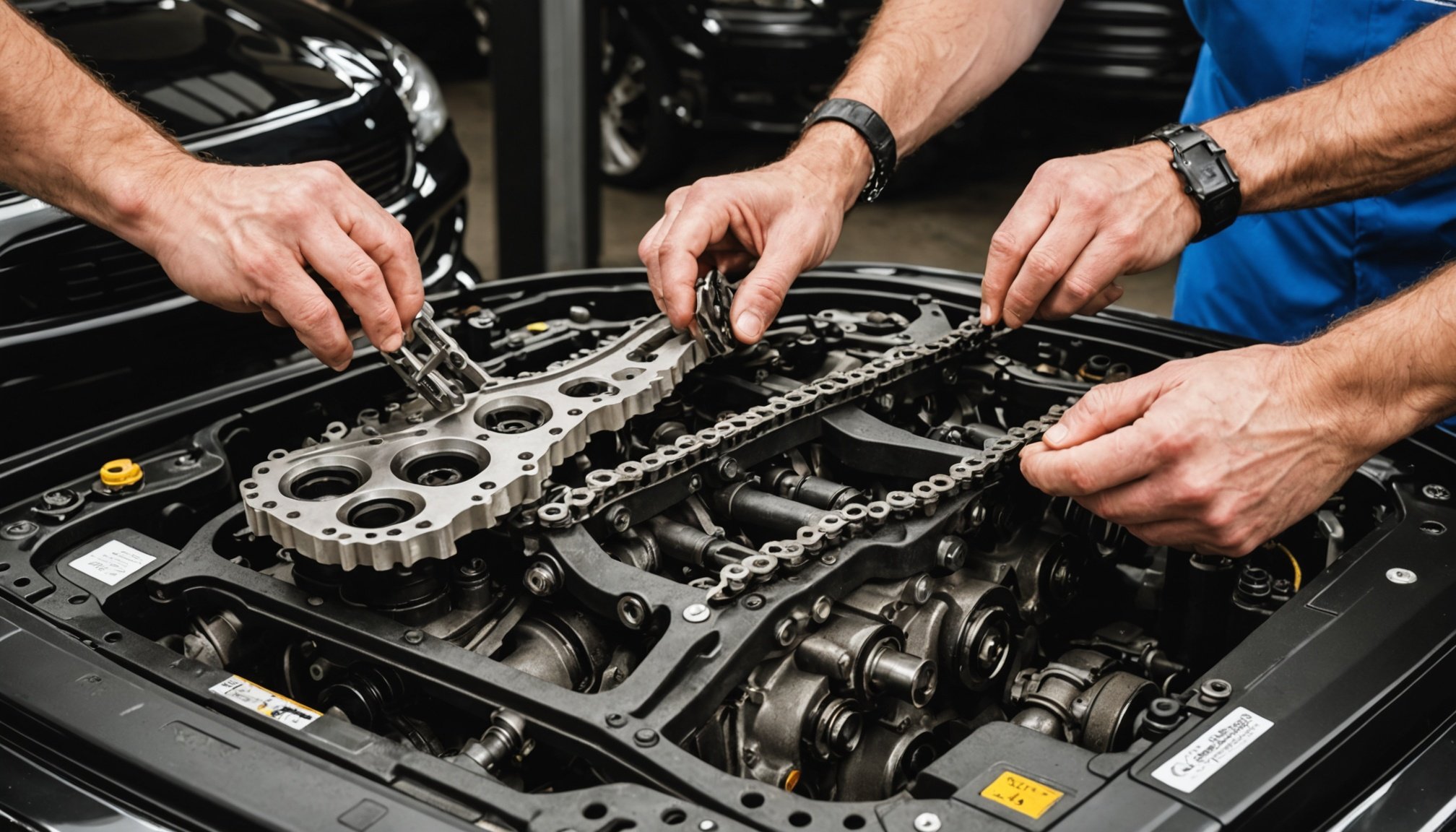Importance of Timing Chains in High-Performance Vehicles
Timing chains are critical for ensuring optimal engine performance and efficiency in high-performance cars. Unlike timing belts, which are made of rubber and may wear out faster, timing chains are typically constructed from durable metal, making them better suited for the demands of high-speed and high-power operations.
Role in Engine Performance
Timing chains synchronize the camshaft and crankshaft, directly influencing the engine’s efficiency and performance. In high-performance settings, precise timing is paramount for optimal power delivery and fuel economy. Chains provide a reliable way to maintain this synchronicity over extended periods.
This might interest you : Mastering Tire Rotation for Four-Wheel Drives: A Guide to Even Wear and Enhanced Safety
Timing Chains vs. Timing Belts
The difference between chains and belts in these vehicles is significant. Timing belts need regular replacement due to wear and tear, whereas timing chains are designed to last the vehicle’s lifetime with proper vehicle maintenance.
Impact of Timing Chain Failure
Failure of a timing chain can dramatically affect a car’s performance, leading to poor engine response or even engine failure. Regular inspections and maintenance help prevent such catastrophic failures, ensuring the vehicle continues to run smoothly and efficiently.
Topic to read : Comprehensive Guide to Testing and Replacing Timing Chains in High-Performance UK Cars
Signs of a Failing Timing Chain
When a timing chain begins to fail, it’s crucial to recognise the symptoms promptly to prevent further engine damage. One of the primary indicators is unusual engine noise. You might hear a rattling or clanking sound, especially during startup or idling, which suggests that the timing chain may be loose or misaligned.
Moreover, performance issues can manifest as another key warning. If you experience unexpected changes in your vehicle’s acceleration or find it lacks the usual power, this could relate to the timing chain not synchronising the engine components effectively. The result is inefficient fuel combustion, which diminishes overall engine performance and responsiveness.
Additionally, keep an eye on your dashboard for any warning lights. A lit engine check light often signals a problem with the timing chain, as modern vehicles can detect when the timing is off. Diagnostics, upon connecting a scanning tool, may reveal error codes that pinpoint timing chain failure as the culprit.
Detecting these symptoms early allows for timely intervention, ensuring your engine continues to run smoothly and efficiently. Regular maintenance and listening to what your engine is telling you can save time and significant repair costs.
Tools and Materials Needed for Testing and Replacement
Engaging in DIY maintenance can be both fulfilling and cost-effective, especially when it comes to automotive repair tasks like timing chain work. To ensure a smooth process, it’s critical to have the right timing chain tools at your disposal. At the very least, you’ll need a timing light, chain tensioner tool, and a crankshaft holding tool to inspect and replace elements of the timing chain system effectively.
For the replacement itself, essential materials include the timing chain, guides, and tensioners. These components are vital for smooth engine operation and synchronisation. While sourcing these parts, prefer OEM (Original Equipment Manufacturer) options for quality assurance. Besides the basic toolset, having a torque wrench can also ensure that components are precisely fitted, preventing future issues.
Safety should always be at the forefront of any automotive repair task. Personal protective equipment such as safety goggles and gloves are necessary to protect against debris or sharp components. Adequate ventilation in the workspace is vital to reduce inhalation risks from dust or fumes. By following these safety precautions, you mitigate the potential for accidents during the repair process and ensure a successful maintenance experience.
Step-by-Step Guide to Testing Timing Chains
Understanding the intricacies of timing chain testing is crucial for maintaining engine health. A methodical approach, including a series of diagnostic checks, ensures thoroughness and accuracy.
Initial Visual Inspection
Begin with a visual inspection as the initial step in the inspection procedure. Look for any visible signs of wear, such as excessive slack or broken links. Check for oil deposits around the timing chain cover, indicating a potential leak. Anomalies in the chain’s appearance can be early warning signs of underlying issues.
Measuring Chain Stretch
Chain stretch is a key indicator of a chain’s condition. To accurately measure it, use a chain gauge or ruler across a section of the chain under tension. The difference in expected and measured length reveals the degree of stretch, which impacts engine timing. Excessive stretch can lead to improper timing, affecting engine performance and increasing the risk of failure.
Analyzing Timing Marks
Correct alignment of timing marks is vital for engine operation. Ensure that marks on the camshaft and crankshaft gears align precisely as per the manufacturer’s specifications. Misalignment can result in inefficient engine performance or potential damage. Regular diagnostic checks focusing on these components are essential to maintain optimal functionality.
Step-by-Step Process of Replacing Timing Chains
Successfully performing a timing chain replacement involves a structured process with attention to detail. Appropriate maintenance steps should be taken to ensure the engine runs smoothly. Let’s delve into the critical steps required for this task.
Preparing the Engine for Replacement
Before diving into the installation guide, meticulous preparation of the engine is essential. First, disconnect the battery to ensure safety. Drain any coolant or oil that might interfere with the procedure. Utilize a checklist to guarantee all necessary tools and components are at hand, including timing covers, tensioners, and gaskets. Properly supporting the engine with a jack can prevent potential damage.
Removing the Old Timing Chain
Once the preparation is complete, careful removal of the old timing chain begins. Start by detaching components like belts and hoses to access the chain. Pay attention to the alignment marks and note the position of each part, ensuring you can revert them during installation. It’s vital to handle each component with caution to avoid unnecessary uprises in time and cost.
Installing the New Timing Chain
The final step is installing the new timing chain. Align the chain accurately with the engine’s marks to accomplish seamless functionality. Torque bolts appropriately as per the manufacturer’s specifications. Following these best practices ensures the new chain is installed correctly, keeping the engine’s operation efficient and reliable.
Common Issues Encountered During Replacement
Replacing a timing chain can be fraught with timing chain problems, especially for those undertaking this task for the first time. Installation challenges often originate from improper alignment or tensioning of the chain. A common mistake is assuming that any slight misalignment is acceptable. However, even a minor discrepancy can lead to significant engine performance issues or failure. Therefore, it’s crucial to be meticulous when setting the chain’s orientation.
Another frequent issue is neglecting to adequately check tension. An incorrectly tensioned chain can either slip or put excessive strain on engine components. This emphasizes the necessity of regularly reviewing the manufacturer’s specifications and guidance for proper chain installation.
Troubleshooting Tips
- Always refer to the vehicle’s service manual. This resource offers adjusted instructions tailored to specific engine types.
- Use tools designed for precise alignment and tensioning to ensure accuracy.
- After initial installation, rotate the engine by hand to verify the chain’s positioning and tension.
Double-checking alignment and tension is of utmost importance for ensuring the overall longevity and reliability of the vehicle’s engine. Familiarity with troubleshooting specifics can significantly aid in overcoming common mistakes and ensuring successful timing chain replacements.
Recommended Best Practices for Maintenance
To ensure the longevity of your vehicle’s timing chain, regular maintenance is crucial. Routine checks can help identify wear and tear early, potentially saving you from costly repairs. One essential aspect of vehicle care is to routinely check the tension of the timing chain. A loose chain can lead to improper engine timing, affecting performance and potentially causing engine damage.
Selecting the best lubricants is also critical in prolonging the life of the timing chain. High-quality engine oils and specialised chain lubricants can reduce friction and wear. Always check your vehicle’s manual or consult a professional to ensure you use the correct type of lubricant for your specific vehicle model.
Regular servicing plays a pivotal role in preventing timing chain issues. Scheduling maintenance every 30,000 to 50,000 miles can help ensure that minor issues are addressed before they become significant. Regular oil changes are particularly crucial as they keep the chain and engine components well-lubricated and functioning smoothly.
Incorporating these longevity tips within your routine vehicle care can effectively extend the lifespan of your timing chain and enhance your vehicle’s overall performance.
DIY vs. Professional Replacement: What to Consider
When deciding between DIY maintenance for a timing chain replacement and hiring professional services, various factors will guide your decision.
For those inclined towards DIY maintenance, the primary advantage is cost savings. Undertaking the replacement yourself can reduce expenses associated with labor fees. However, it requires a robust understanding of mechanical systems and access to specific tools. Mistakes in this process can lead to significant engine damage, resulting in higher repair costs.
On the other hand, professional services ensure the job is completed with expertise and precision. Professionals have the necessary experience and tools to undertake the replacement efficiently, reducing the risk of errors. It is important to consider their reputation and skill level when choosing a service provider.
Cost analysis presents a critical factor. While DIY may initially seem more economical, unforeseen complications could incur additional expenses. Professional replacement generally entails higher upfront costs but may offer long-term savings through service guarantees and maintenance checks that extend the engine’s lifespan.
Ultimately, the choice hinges on your skills, tools available, and financial implications. Weighing these elements will help determine the most beneficial approach for your timing chain replacement.
Comparison of Various Timing Chains for High-Performance UK Cars
When it comes to choosing a timing chain brand for high-performance UK cars, it’s crucial to consider both reliability and longevity. Popular options include brands like Cloyes, IWIS, and SKF, known for their durable and efficient chains. Each brand has its strengths, making them suitable for specific car models and performance needs.
Performance Analysis
In the realm of high-performance cars, the demands on a timing chain are intensified due to elevated RPMs and torque. Cloyes offers chains renowned for their wear resistance, often preferred in vehicles such as the Jaguar XE or Aston Martin DB11, which demand high endurance.
IWIS, on the other hand, provides premium solutions with a focus on reduced friction and noise. This makes them a prime choice for the McLaren 570S. Their chains are engineered to maximise engine efficiency, crucial for the car’s dynamic performance.
SKF is another notable brand, with its chains utilised frequently in models like the Bentley Continental. Their reliable performance over extended mileage makes them indispensable for both racing enthusiasts and luxury touring.
Ultimately, it’s about aligning the timing chain brand with the specific performance attributes of your high-performance UK car.










